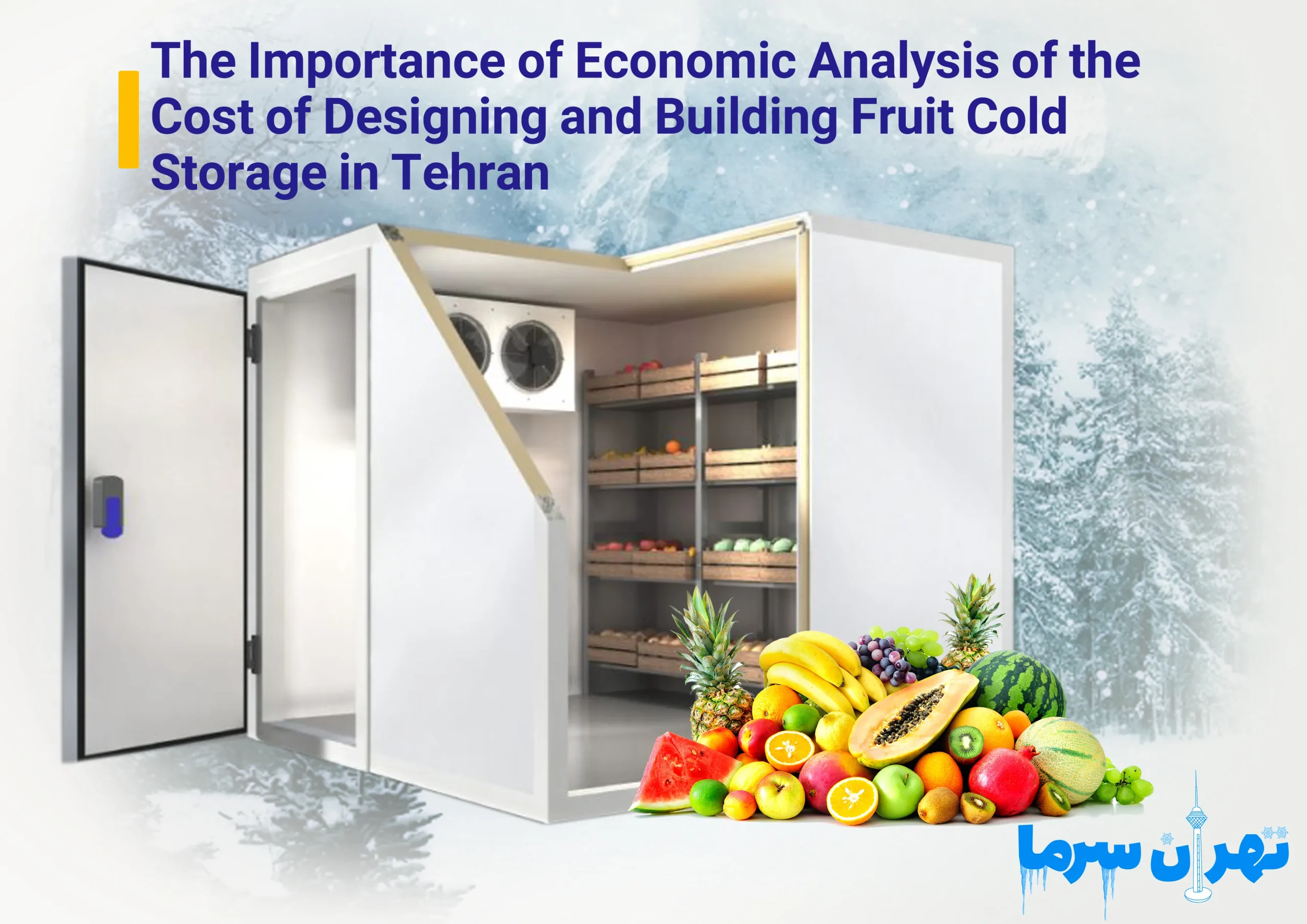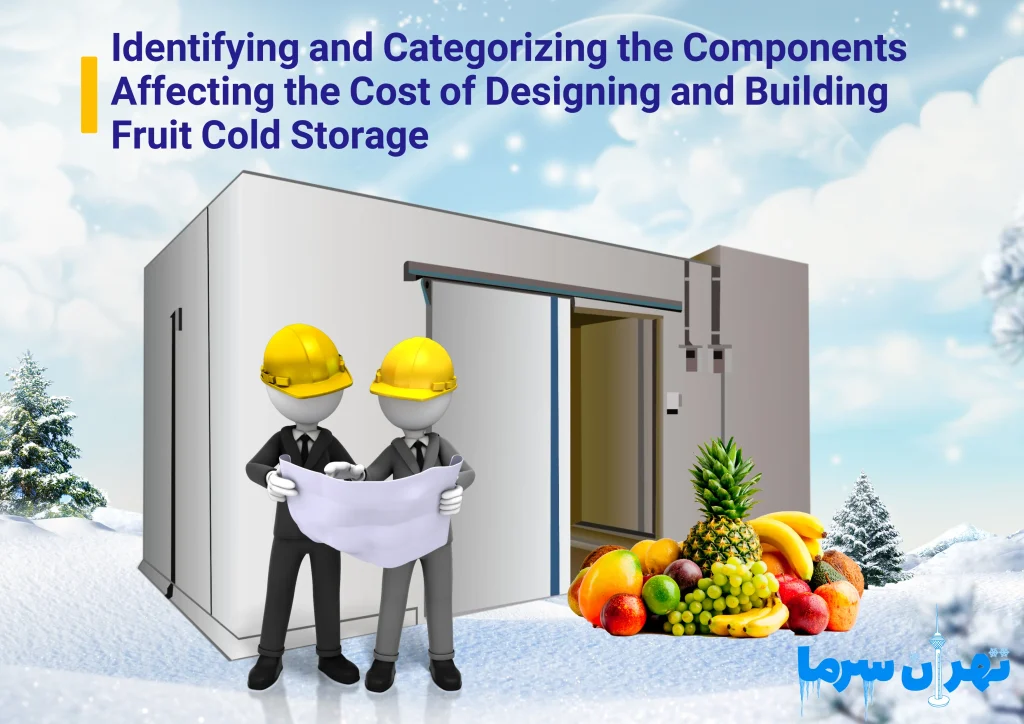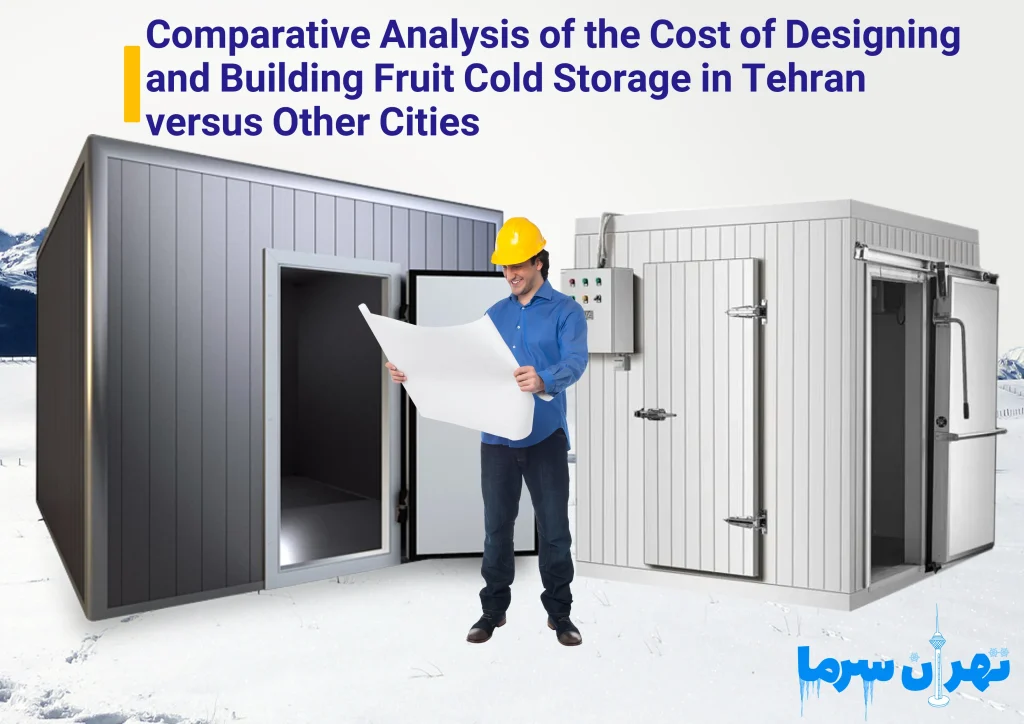The Importance of Economic Analysis of the Cost of Designing and Building Fruit Cold Storage in Tehran

The cost of designing and building a fruit cold storage, as well as the expenses associated with it, varies depending on factors such as capacity, type of equipment, quality of insulation, and the technologies used. Additionally, the cost of designing and building fruit cold storage in Tehran can differ significantly from other cities due to specific market conditions, transportation expenses, specialized labor wages, and space constraints.
The importance of economic analysis of the cost of designing and building fruit cold storage in Tehran goes beyond a simple financial calculation and becomes a strategic process for ensuring return on investment and optimizing project performance.
In a city like Tehran, which is recognized both as a major consumption center and one of the main distribution hubs in the country, decisions regarding fruit cold storage construction must be based on a comprehensive and precise assessment. The absence of this analysis can lead to incorrect estimates, unforeseen cost increases, and reduced long-term profitability.
The Importance of Considering the Economic Aspect in the Cost of Designing and Building Fruit Cold Storage
From an economic perspective, accurate estimation of the cost of designing and building fruit cold storage in Tehran should cover all direct and indirect cost factors. These factors include site selection, type of technologies used, insulation quality, storage capacity, and even legal requirements and health standards.
In Tehran, due to population density and high land value, costs related to site selection and initial infrastructure can account for a significant portion of the total investment. Economic analysis should be able to balance these costs with precise forecasts of future revenue streams to ensure the project’s financial stability.
The Role of High Population and Demand in the Cost of Designing and Building Fruit Cold Storage
Moreover, the Tehran market has specific characteristics that make the economic analysis of fruit cold storage construction costs more complex. High demand for fruit storage throughout the year, competition among investors, and fluctuations in equipment and construction material prices are factors that can affect the final cost and return on investment. Without evaluating these variables, investments may face unforeseen risks that impact project profitability.
On the other hand, precise economic analysis can help identify opportunities to reduce costs and increase efficiency. For example, using smart temperature and humidity management systems, or selecting innovative technologies in refrigeration systems, may increase initial costs relatively but significantly reduce operational expenses in the long term.
In Tehran, where energy and labor costs are continuously rising, such analysis-based decisions play a key role in maintaining the competitiveness of cold storage facilities.
The Cost of Designing and Building Fruit Cold Storage in Tehran
The importance of economic analysis of the cost of designing and building fruit cold storage in Tehran lies in the fact that this process is not merely a simple financial calculation but a tool for strategic decision-making and risk management.
By conducting this analysis, investors can have a clear understanding of costs, revenues, and the return-on-investment timeline, allowing the project to be designed and executed in alignment with Tehran’s specific market conditions and actual needs. Such an approach not only increases the likelihood of project success but also ensures its sustainability and profitability in the coming years.
Identifying and Categorizing the Components Affecting the Cost of Designing and Building Fruit Cold Storage
Identifying and categorizing the components affecting the cost of designing and building fruit cold storage is one of the most important steps in planning and executing such projects. This step helps investors and designers obtain a clear picture of the cost structure and make decisions based on accurate and realistic information. Without this understanding, cost estimates may be general and opaque, greatly increasing the likelihood of budget shortfalls or sudden expense spikes during the project.
The costs of designing and building fruit cold storage can be divided into two main categories: capital costs and operational costs. In the capital category, factors such as land purchase, construction of the facility, installation of refrigeration equipment, and implementation of insulation systems are included.
Each of these items, depending on the selected quality and desired capacity, can represent a significant portion of the initial investment. In contrast, operational costs include energy consumption, equipment maintenance, labor costs, and other daily expenses, which recur over the project’s lifetime and directly affect profitability.
A key point in this categorization is to consider the relative share of each component in the total project cost. For instance, in cold storage facilities located in hot or densely populated areas like Tehran, costs related to insulation and refrigeration systems are usually higher than in colder regions, due to the greater need for intensive temperature and humidity control. Conversely, in areas where land is cheaper and labor costs are lower, the share of these components in the final cost will be smaller.
Additionally, external factors such as exchange rates, fluctuations in raw material prices, and government regulations can affect both cost categories. For example, an increase in the price of steel or sandwich panels directly raises construction costs, while changes in electricity or fuel tariffs can impact operational expenses. Therefore, the analysis and categorization of cost components must be dynamic and up-to-date so that investors can make timely corrective decisions in response to market changes.
Overall, accurately identifying and categorizing the components affecting the cost of designing and building fruit cold storage is not only a tool for budget control but also a foundation for optimizing design and selecting appropriate technologies. This approach allows for reducing financial risks, increasing return on investment, and constructing a project that is economically and operationally efficient.
The Impact of Modern Technologies and International Standards on the Cost of Designing and Building Fruit Cold Storage
The impact of modern technologies and international standards on the cost of designing and building fruit cold storage is one of the key topics in the modern refrigeration and storage industry. Today, using advanced equipment and adhering to recognized global standards not only affects the quality and efficiency of the cold storage but also transforms its cost structure.
Investors and project executors should understand that implementing these technologies and standards may increase the initial cost, but in the long term, it can lead to significant savings in operational expenses and prolong the lifespan of equipment.
Modern technologies in fruit cold storage include the use of smart temperature and humidity control systems, energy-efficient compressors, refrigeration systems based on environmentally friendly refrigerants, and energy optimization solutions. These technologies provide stable and precise conditions for fruit storage, reducing waste and preserving product quality. As a result, although the initial investment is higher, the economic return and customer satisfaction over time offset this cost.
On the other hand, compliance with international standards such as HACCP, ISO 22000, and ASHRAE not only increases market trust and enables product export but also affects the design and selection of equipment. Following these standards requires the use of high-quality materials and equipment, continuous monitoring systems, and adherence to safety and hygiene principles.
These requirements can increase the final project cost, but in return, they minimize legal and health risks and add significant value to the project.
Another important factor is the convergence of technology and standards. For example, using sensors and integrated data software to monitor cold storage performance not only ensures compliance with quality standards but also enables preventive management and reduces breakdowns. This type of technology investment, although costly during implementation, significantly lowers maintenance and operational downtime expenses.
The impact of modern technologies and international standards on the cost of building fruit cold storage is a combination of increased initial costs and reduced long-term expenses. An approach that focuses solely on the initial price may deprive the project of competitive advantages and economic sustainability, while considering the equipment lifecycle and operational efficiency shows that this investment is not only reasonable but necessary.
Modeling the Effects of Geographic Location and Market Conditions on the Cost of Designing and Building Fruit Cold Storage
Modeling the effects of geographic location and market conditions on the cost of designing and building fruit cold storage is one of the vital tools for planning and decision-making in refrigeration investments. Geographic location directly impacts project costs; factors such as climate conditions, access to energy resources, transportation infrastructure, and proximity to production and consumption centers can significantly alter land, construction, and equipment costs.
In regions with high temperatures or humidity, the need for advanced cooling systems and precise insulation increases, raising the initial project cost, whereas in colder regions, pressure on cooling systems is lower, and costs are relatively less. On the other hand, market conditions also play a decisive role in determining the cost of building fruit cold storage. Demand for storage, competition among investors, fluctuations in equipment and material prices, and government policies and tariffs all influence the cost structure and return on investment.
Modeling these effects allows investors to simulate different scenarios, anticipate potential risks, and make decisions based on economic and geographic realities. This approach not only helps optimize budget and resource allocation but also ensures that the designed cold storage aligns with market needs and environmental conditions, providing maximum efficiency and profitability throughout the project’s lifecycle.
Comparative Analysis of the Cost of Designing and Building Fruit Cold Storage in Tehran versus Other Cities
A comparative analysis of the cost of designing and building fruit cold storage in Tehran versus other cities shows that the project location significantly affects final costs. In Tehran, due to population density, a widespread distribution network, and easy access to equipment suppliers and skilled labor, investment in cold storage construction can offer considerable economic advantages. These conditions reduce logistics and transportation costs and allow faster access to consumer markets, a benefit that is less common in smaller cities or remote areas.
In other cities, limited access to equipment and technical services, higher transportation costs, and lower demand levels can increase the cost of building fruit cold storage. Additionally, less competition among investors may result in projects with lower efficiency and higher operational costs. Therefore, a comparative analysis between Tehran and other cities allows investors to obtain a clearer picture of each region’s economic and market conditions and make decisions based on this data.
In general, such analyses not only help identify price differences but also aid in strategic planning for selecting the location of the cold storage and optimizing cost structures. Considering these factors, investing in Tehran can be an attractive option for fruit cold storage projects due to reduced risks and increased returns, whereas in other cities, a more detailed assessment of local conditions and the market is necessary.
Optimal Cost of Designing and Building Fruit Cold Storage with Tehran Sarma Engineering Company
The optimal cost of designing and building fruit cold storage with Tehran Sarma Engineering Company combines high quality, economic efficiency, and adherence to technical standards. With extensive experience in designing and implementing cold storage projects in Tehran and other cities, the company can efficiently meet client needs according to the desired capacity, type of fruit, and environmental conditions.
Tehran Sarma’s focus on using modern technologies, precise temperature and humidity control systems, and standard insulation ensures that, in addition to guaranteeing product quality and safety, operational and initial investment costs are also managed and minimized. Therefore, partnering with this company provides access to optimal pricing along with professional services and continuous support, helping investors achieve an efficient and economically viable project.
For more information about cold storage construction costs, you can visit Tehran Sarma’s website or contact them at 09121906418 and 02177972256.
Ultimately, the correct selection and execution of a fruit cold storage project—both in terms of equipment quality and proper design—play a crucial role in increasing efficiency and reducing long-term costs. A thorough review of the cost of designing and building fruit cold storage, comparison under various conditions, and attention to price differences in Tehran versus other regions can support informed decision-making and safer investment.
Source: https://guntner.com/




 سردخانه
سردخانه برق
برق کمپرسور
کمپرسور کمپرسور بیتزر
کمپرسور بیتزر کمپرسور کوپلند
کمپرسور کوپلند کمپرسور بوک
کمپرسور بوک کمپرسور دانفوس
کمپرسور دانفوس کمپرسور منیروپ دانفوس
کمپرسور منیروپ دانفوس کمپرسور امبراکو
کمپرسور امبراکو کمپرسور پاناسونیک
کمپرسور پاناسونیک کمپرسور سابکول
کمپرسور سابکول کمپرسور کوپلند
کمپرسور کوپلند کمپرسور اسکرال کوپلند
کمپرسور اسکرال کوپلند کمپرسورفراسکلد
کمپرسورفراسکلد کمپرسور رفکامپ
کمپرسور رفکامپ کمپرسور اسکرال دانفوس
کمپرسور اسکرال دانفوس گاز مبرد
گاز مبرد گاز R22
گاز R22 گاز R134
گاز R134 گاز R404
گاز R404 گاز R407
گاز R407 گاز R410
گاز R410 گاز R508
گاز R508 کندانسور هوایی
کندانسور هوایی اواپراتور
اواپراتور اواپراتور آرشه
اواپراتور آرشه اواپراتور صابکول
اواپراتور صابکول اواپراتور آسه
اواپراتور آسه اواپراتور نیک
اواپراتور نیک اواپراتور آرتک
اواپراتور آرتک اواپراتور نوین
اواپراتور نوین اواپراتور تبادل کار
اواپراتور تبادل کار درب
درب ساندویچ پنل
ساندویچ پنل فن سردخانه
فن سردخانه روغن کمپرسور سانیسو
روغن کمپرسور سانیسو متعلقات سردخانه
متعلقات سردخانه